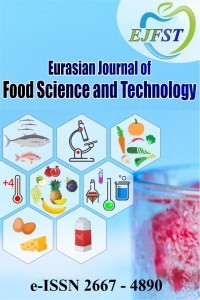Characterization of fatty acids composition in Iranian Phishomi extra-virgin olive oil
Characterization of fatty acids composition in Iranian Phishomi extra-virgin olive oil
___
- Amanpour, A., Kelebek, H., Kesen, S., & Selli, S. (2016). Characterization of Aroma-Active Compounds in Iranian cv. Mari Olive Oil by Aroma Extract Dilution Analysis and GC–MS-Olfactometry. Journal of the American Oil Chemists’ Society, 93(12), 1595–1603.
- Benito, M., Oria, R., & Sánchez-Gimeno, A. C. (2010). Characterization of the olive oil from three potentially interesting varieties from Aragon (Spain). Food Science and Technology International, 16(6), 523–530.
- Cerretani, L., Bendini, A., Caro, A. Del, Piga, A., Vacca, V., Caboni, M. F., & Gallina Toschi, T. (2006). Preliminary characterisation of virgin olive oils obtained from different cultivars in Sardinia. European Food Research and Technology, 222(3–4), 354–361.
- Codex Alimentarius Commission. (2003). Standard for olive oils and olive pomace oils.
- Hashempour, A., Ghazvini, R. F., Bakhshi, D., Aliakbar, A., Papachatzis, A., & Kalorizou, H. (2010). Characterization of Virgin Olive Oils ( Olea Europaea L.) from Three Main Iranian Cultivars, “Zard”, “Roghani” and “Mari” in Kazeroon Region. Biotechnology & Biotechnological Equipment, 24(4), 2080–2084.
- Homapour, M., Ghavami, M., Piravi-Vanak, Z., & Hosseini, S. E. (2014). Chemical properties of virgin olive oil from Iranian cultivars grown in the Fadak and Gilvan regions. Grasas Y Aceites, 65(4), 43.
- IOOC. (2001). Trade standard applying to olive oil and olive pomace oil.
- Kelebek, H., Kesen, S., & Selli, S. (2015). Comparative Study of Bioactive Constituents in Turkish Olive Oils by LC-ESI/MS/MS. International Journal of Food Properties, 18(10), 2231–2245.
- Kharazi, S. H., Kenari, R. E., Amiri, Z. R., & Azizkhani, M. (2012). Characterization of Iranian virgin olive oil from the Roodbar region: A study on Zard, Mari and Phishomi. Journal of the American Oil Chemists’ Society, 89(7), 1241–1247.
- Luna, G., & Aparicio, R. (2002). Characterisation of monovarietal virgin olive oils. Eur. J. Lipid Sci. Technol, 104, 614–627.
- Mraicha, F., Ksantini, M., Zouch, O., Ayadi, M., Sayadi, S., & Bouaziz, M. (2010). Effect of olive fruit fly infestation on the quality of olive oil from Chemlali cultivar during ripening. Food and Chemical Toxicology, 48(11), 3235–3241.
- Vekiari, S. A., Oreopoulou, V., Kourkoutas, Y., Kamoun, N., Msallem, M., Psimouli, V., & Arapoglou, D. (2010). Characterization and seasonal variation of the quality of virgin olive oil of the Throumbolia and Koroneiki varieties from southern Greece. Grasas Y Aceites, 61(3), 221–231.
- Yayın Aralığı: Yılda 2 Sayı
- Başlangıç: 2017
- Yayıncı: İlknur BAĞDATLI
An Overview of Nano-Scale Food Emulsions: A Mini Review
Şelale YALÇINÖZ, Emine ERÇELEBİ
Merve Gozde COSKUN, Perihan YOLCI OMEROGLU, Omer Utku COPUR
Temperature dependency of sweet cherry concentrate colour: a kinetic study
Şelale YALÇINÖZ, Emine ERÇELEBİ
Characterization of fatty acids composition in Iranian Phishomi extra-virgin olive oil
Asghar AMANPOUR, Songul KESEN, Hasim KELEBEK, Serkan SELLI
MATHEMATICAL MODELING OF APRICOT DRYING
Gülşah KANBUR, Yusuf CUFADAR, Rabia GÖÇMEN, Ahmet ÜNVER
Effects of Cultivar, Maturity Index and Growing Region on Fatty Acid Composition of Olive Oils
Songül KESEN, Asghar AMANPOUR, A. Salih SONMEZDAG, Hasim KELEBEK, Serkan SELLİ
Physicochemical and Nutritional Properties of Bitter Melon at Four Maturation Stages
Yasin OZDEMIR, Aysun OZTURK, Senem TUFEKCI, Ozge KESKINEL, Rena İ. KOSTI
